Answer these simple questions and we will find you the BEST prices
Which type of solar quotes do you need?
It only takes 30 seconds
100% free with no obligation

Tell us what you need to find a matching specialist

Get free quotes from professionals near you

Compare offers and choose the one that best matches your need
- whatcost.co.uk
- Home Insulation
- Wall Insulation
- Cavity Wall Insulation
- Pumped Cavity Insulation
Pumped Cavity Wall Insulation: How Does It Work?

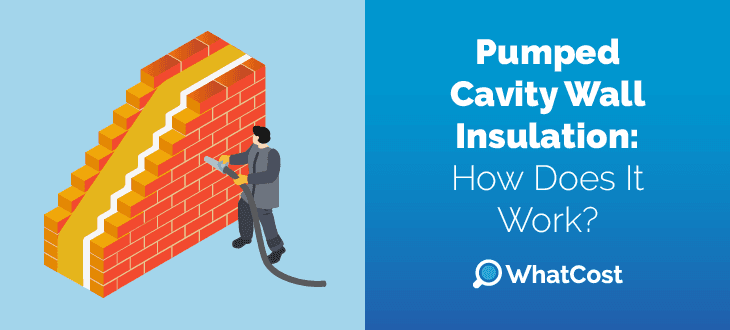
- The cost of pumped cavity wall insulation typically ranges from £1,100 to £4,600, depending on the size of your property, the insulation material selected, and your location.
- Installing high-quality pumped cavity wall insulation can save you up to £470 annually on energy bills, depending on your property type.
- Professional installers drill 22mm holes into your external walls and pump insulation material into the cavity, creating an efficient thermal barrier to reduce heat loss.
Seventy-one percent of UK homes have cavity walls, but alarmingly, nearly 29% are poorly insulated or not insulated at all. This gap in insulation can significantly impact energy bills, especially with costs continuing to rise amid the ongoing energy crisis—Ofgem has reported a 1.2% increase.
Proper cavity insulation is a game-changer, improving your home’s thermal efficiency and reducing energy expenses. For a semi-detached home, upgrading insulation could save you up to £230 annually, making it one of the smartest investments for lowering energy costs.
Cavity wall insulation comes in various forms, each offering different levels of thermal performance. The right method ensures maximum energy efficiency in your home. One of the most effective and widely used options is pumped cavity wall insulation, which is known for its reliability and excellent thermal results.
In this WhatCost guide, we’ll cover everything you need about pumped cavity wall insulation, including its work, the materials involved, associated costs, and much more. Armed with this knowledge, you can make an informed decision and choose the best insulation method for your home.
To determine if pumped cavity wall insulation is right for you and your budget, consult a trusted professional. WhatCost can help! Fill out our quick 30-second form to connect with up to four free quotes from top-rated specialists in your area. Don’t wait, click below to start your journey to a warmer, more energy-efficient home!
- Describe your needs
- Get free quotes
- Choose the best offer
It only takes 30 seconds



How does pumped cavity wall insulation work?
Pumped cavity wall insulation installation involves filling the gap between the inner and outer walls of a property (the cavity) with an insulating material. This process enhances the thermal efficiency of the building, reducing heat loss and improving energy performance. Here’s how it works step by step:
1. Assessment and preparation

A professional installer will visit your home to inspect your property and determine whether your walls suit pumped cavity wall insulation. Understanding whether your walls are cavity walls is a crucial first step before proceeding. Here are some simple ways to check if you have cavity walls:
- Age of your home: Homes built after 1920 will likely have cavity walls.
- Brick pattern: Cavity walls typically feature an even brick pattern, with all bricks laid lengthwise. In contrast, solid walls often display an uneven pattern.
- Wall thickness: Measure the thickness of your walls at a door or window. Cavity walls are generally 260mm thick or more.
Once cavity walls are confirmed, the cavity wall insulation installer will check for existing insulation and ensure the walls are free from damage or damp issues. If the walls are suitable, they will begin the preparation process. This involves drilling 22mm holes into the external wall in a predetermined pattern. These holes allow for even distribution of the insulation material during installation.
2. Pumping insulation into the cavity

After your walls have been assessed and prepared, the installer will use specialised equipment to inject the selected insulation material into the drilled holes. The insulation is applied under controlled pressure to ensure the cavity is entirely and evenly filled, eliminating gaps and preventing cold spots.
The effectiveness of the insulation largely depends on the material chosen, as each type has an R-value, a measure of its thermal performance.
R-value measures how well a material resists heat flow. The higher the R-value, the better it insulates.
Selecting the right material is also crucial for meeting UK building regulations, which require a cavity wall to achieve a U-value of 1.6 W/m²K or lower. By choosing a material with a high R-value, you can effectively reduce the U-value of your walls, improving both energy performance and compliance.
3. Sealing the gaps

After the cavity is fully insulated, the drilled holes are carefully sealed. The entire process is completed within two to three hours, depending on the size of your home.
Once the installation is finished, the professionals will perform a thorough inspection to ensure the insulation has been installed correctly and is functioning effectively. They will also remove any leftover materials or equipment, leaving your property clean, tidy, and ready to enjoy the benefits of improved insulation.
What are the different types of pumped insulation?
Selecting the right type of pumped cavity wall insulation is crucial to ensuring maximum energy efficiency for your home. There are several cavity wall insulation types available, each with its advantages and disadvantages. Understanding these differences will help you choose the best solution to match your preferences, needs, and budget.
Mineral wool
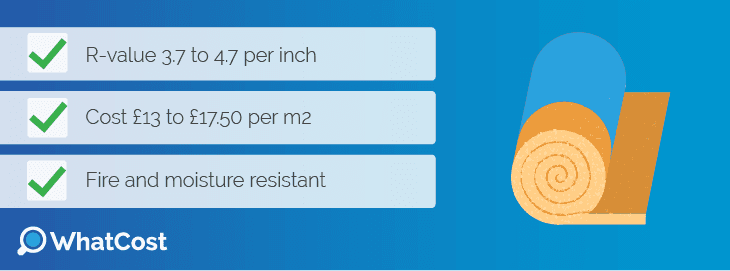
Mineral wool is a fibre-based insulation material that resembles wool in appearance but is much denser. This density makes it an excellent choice for soundproofing and thermal insulation. With an average R-value of 3.7 and 4.3 per inch, mineral wool offers slightly lower thermal performance than PIR and XPS insulation but excels in other key areas.
Mineral wool is exceptionally fire resistance, making it a great choice for enhancing fire safety in your home. Additionally, it is moisture-resistant, meaning it won’t absorb water, which helps prevent mould and mildew growth. The cost of mineral wool insulation typically ranges from £13 to £17.50 per m², depending on your chosen type and manufacturer.
Polystyrene beads
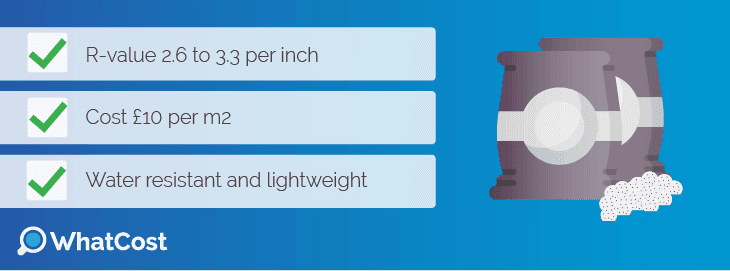
Polystyrene beads, often called EPS beads, are a popular choice for pumped cavity wall insulation and are priced at approximately £10 per m², making them a cost-effective option. These beads are lightweight and water-resistant, which helps reduce the risk of dampness in your walls by preventing water absorption. The beads expand to fill the cavity during installation, ensuring consistent and even insulation performance without gaps or cold spots.
Although EPS beads are petroleum-based, certain varieties are recyclable, offering a more environmentally friendly option than traditional polystyrene. They also provide good thermal performance with a typical R-value of 2.6 to 3.3 per inch, balancing affordability and energy efficiency. Additionally, their durability and resistance to settling over time make them a long-lasting solution for cavity wall insulation.
Polyurethane foam
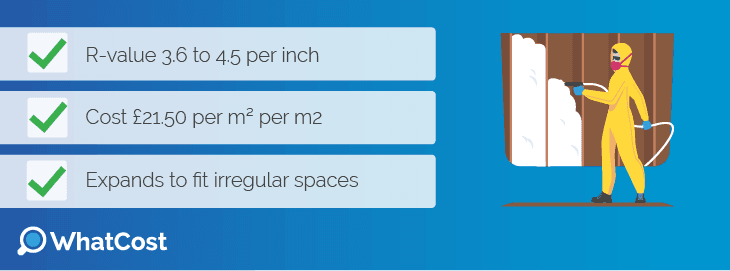
Polyurethane foam is a high-performance insulation material that costs approximately £21.50 per m². With an impressive R-value of 3.6 to 4.5 per inch, it provides excellent thermal performance, making it highly effective at reducing heat loss and improving energy efficiency.
This material is particularly beneficial in homes that require a solid air barrier to prevent drafts and heat leakage. Its ability to expand and fill irregular spaces ensures complete coverage, even in properties with uneven or complex wall structures.
Cellulose
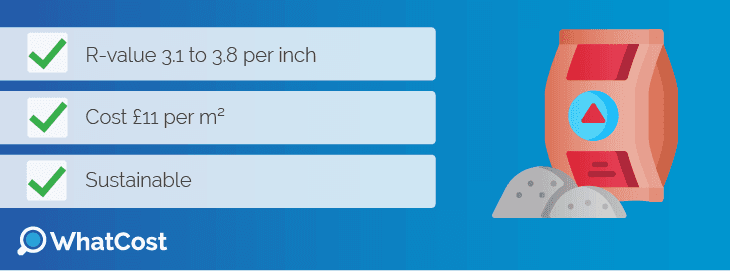
Cellulose is a loose-fill insulation material crafted from recycled paper. It is an eco-friendly option for pumped cavity wall insulation. Available in wet or dry form, it is an excellent choice for homeowners looking to reduce their carbon footprint while improving their home’s energy efficiency.
Costing an average of £11 per m², cellulose insulation is a budget-friendly option that offers a respectable R-value of 3.1 to 3.8 per inch. This level of thermal performance makes it practical for improving energy efficiency. Additionally, cellulose is treated with boric acid, making it naturally resistant to fire, pests, and mould growth.
Pumped cavity wall insulation cost

Pumped cavity wall insulation cost can range between £1,100 to £4,600 depending on your property size, the material you choose, your location and whether you are opting for full-fill cavity insulation or partial fill. Here is a full cost breakdown of pumped cavity wall insulation price averages per property type in England, Wales and Scotland.
| Property type | Average cost |
|---|---|
| Mid-floor flat | £1,100 |
| Mid-terrace house | £1,500 |
| Detached bungalow | £2,000 |
| Semi-detached house | £2,700 |
| Detached house | £4,300 |
Cavity wall insulation in Northern Ireland is typically slightly lower in cost compared to the rest of the UK:
| Property type | Average cost |
|---|---|
| Mid-floor flat | £550 |
| Mid-terrace house | £750 |
| Detached bungalow | £1,000 |
| Semi-detached house | £1,300 |
| Detached house | £2,100 |
Pumped cavity wall insulation can be a significant investment, particularly during an energy crisis. However there are insulation grants are available to help reduce these costs. To access these grants and quotes, you'll need to work with a certified insulation installer.
Fortunately, WhatCost simplifies this process for you. By completing our quick 30-second form, you'll receive up to four free quotes from top-rated certified insulation specialists in your area. Skip the hassle of comparing quotes yourself and let us make it easy. Click below to get started and learn more!
- Describe your needs
- Get free quotes
- Choose the best offer
It only takes 30 seconds



Pros & cons of pumped cavity wall insulation
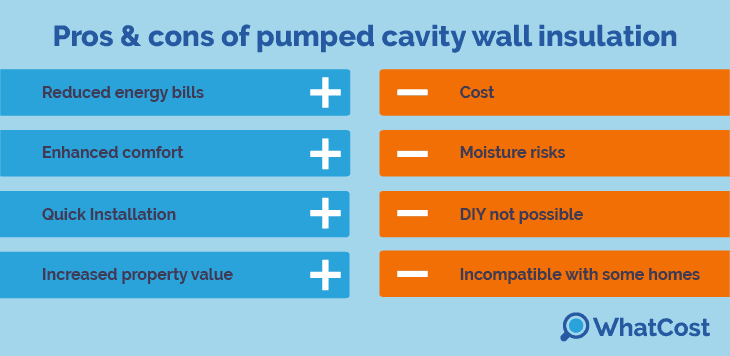
Pumped cavity wall insulation offers a range of benefits for your home. Still, it’s essential to carefully weigh the pros and cons before deciding. Understanding the advantages and potential drawbacks will help you make an informed choice.
Pros
- Reduced energy bills: Depending on your property type and location, you can save between £110 and £470 annually on energy bills.
- Enhanced comfort: This insulation method helps maintain a consistent indoor temperature, keeping your home warmer in winter and cooler in summer. It also eliminates drafts and reduces temperature fluctuations, improving overall comfort.
- Quick installation: The installation process is straightforward, typically taking only two to three hours. This means minimal disruption to your home and daily routine.
- Increased property value: By improving your home’s energy rating certificate, pumped cavity wall insulation can make your property more attractive to buyers. It can increase the market value of your home by as much as 14%.
Cons
- Upfront cost: The cost of installation can be significant, depending on your property size and the material used.
- Moisture risks: Improper installation or unsuitable material choice can lead to moisture seeping through the walls, causing damp issues.
- Not suitable for all homes: Not all homes are compatible with pumped cavity wall insulation. Properties with solid walls, timber-framed structures, or existing structural issues may require alternative insulation methods.
- DIY not possible: DIY installation is not an option for this method. The process requires specialized equipment and expertise, so hiring a reliable, certified installer is crucial to avoid substandard work.
To ensure the best results, assess your home's suitability, choose the right insulation material, and work with a reliable professional. With proper planning and installation, it can greatly improve your home's energy efficiency and comfort.
Is pumped insulation a good solution for your home?
Pumped cavity wall insulation can be an excellent solution for many homes. However, its success depends on selecting the right material, ensuring proper installation, and confirming that your property suits this method.
Before deciding, it’s essential to have your home assessed by a certified professional. Factors such as the condition of your walls, the type of construction, and existing insulation all play a role in determining if pumped insulation is the right fit for your property. A professional installer can evaluate these aspects and recommend the best solution tailored to your needs. To make the process easier, obtaining multiple quotes from trusted professionals is wise. This allows you to compare costs and ensures you choose an experienced installer who can deliver high-quality results.
At WhatCost, we simplify this process for you. By completing our quick 30-second form, you can receive up to four free quotes from top-rated insulation specialists in your area. With no hidden costs or obligations, this is a hassle-free way to ensure your home gets the best insulation solution.
Don’t leave your home’s energy efficiency to chance—opt for professional installation to maximise the benefits of pumped insulation. Click below to start and take the first step toward a warmer, more energy-efficient home!
- Describe your needs
- Get free quotes
- Choose the best offer
It only takes 30 seconds



FAQ
Yes, cavity wall insulation can be pumped into the wall using specialised equipment to fill the cavity evenly.
Yes, pumping cavity walls is an effective way to improve energy efficiency, reduce heat loss, and lower energy bills when installed correctly.
The best insulation depends on your needs, but materials like EPS beads, mineral wool, or polyurethane foam are commonly used for their thermal performance and durability.
The U-value of pumped cavity wall insulation is 1.6 W/m²K as per the UK building regulations.

Caoimhe is an experienced content writer and researcher who is passionate about providing accessible information to every reader. With a background in English literature and Sociology, she combines the two disciplines to create cohesive, well-thought-out, and well-informed pieces.
- Describe your needs
- Get free quotes
- Choose the best offer
It only takes 30 seconds



